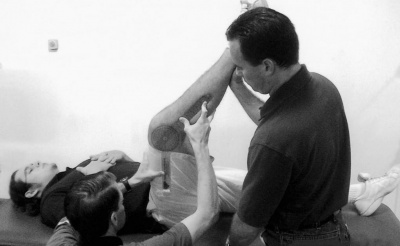Passive Knee Extension Test
Purpose[edit | edit source]
The purpose of the Passive knee extension test is to examine the joint range, quality of movement, 'end feel' of the joint and can also measure tightness of the hamstring muscles. [1]
Technique[edit | edit source]
The patient is positioned in supine with the hip of the tested leg in 90 degrees of flexion.The contralateral leg stays flat on the examination table. The clinician extends the knee until reaching the maximal tolerable stretch of the hamstring muscle as indicated by the patient with the ipsilateral hip remaining in 90 of flexion. The knee angle is then measured. [2]
Goniometer Placing[edit | edit source]
The Axis of the goniometer should be places at the lateral epicondyle of the femur. The moving arm should point towards the lateral malleolus and the stationary should point towards the greater trochanter.[3]
Normal Test Values[edit | edit source]
Davis et al[5] found the normal values of the popliteal angle (180 degrees - knee extension angle) in a population of healthy college student to be as follows:
| Men | Women | Mean |
| 71.6 | 77.7 | 74.6 |
Reliability[edit | edit source]
The Passive knee extension test has good intra-tester reliability [ICC: 0.97-0.98].[6]
References[edit | edit source]
- ↑ Fredriksen H, Dagfinrud H, Jacobsen V, Maehlum S. Passive knee extension test to measure hamstring muscle tightness. Scandinavian journal of medicine & science in sports. 1997 Oct 1;7(5):279-82.
- ↑ Reurink G, Goudswaard GJ, Oomen HG, Moen MH, Tol JL, Verhaar JA, Weir A. Reliability of the active and passive knee extension test in acute hamstring injuries. The American journal of sports medicine. 2013 Aug 1;41(8):1757-61.
- ↑ Reese NB, Bandy WD. Joint range of motion and muscle length testing. Elsevier Health Sciences; 2016 Mar 31.
- ↑ Nelson RT, Bandy WD. Eccentric training and static stretching improve hamstring flexibility of high school males. Journal of athletic training. 2004 Jul 1;39(3):254.
- ↑ Davis DS, Quinn RO, Whiteman CT, Williams JD, Young CR. Concurrent validity of four clinical tests used to measure hamstring flexibility. The Journal of Strength & Conditioning Research. 2008 Mar 1;22(2):583-8.
- ↑ Youdas JW, Krause DA, Hollman JH, Harmsen WS, Laskowski E. The Influence of Gender and Age on Hamstring Muscle Length in Healthy Adults. Journal of Orthopaedic & Sports Physical Therapy 2005:35:246-252







